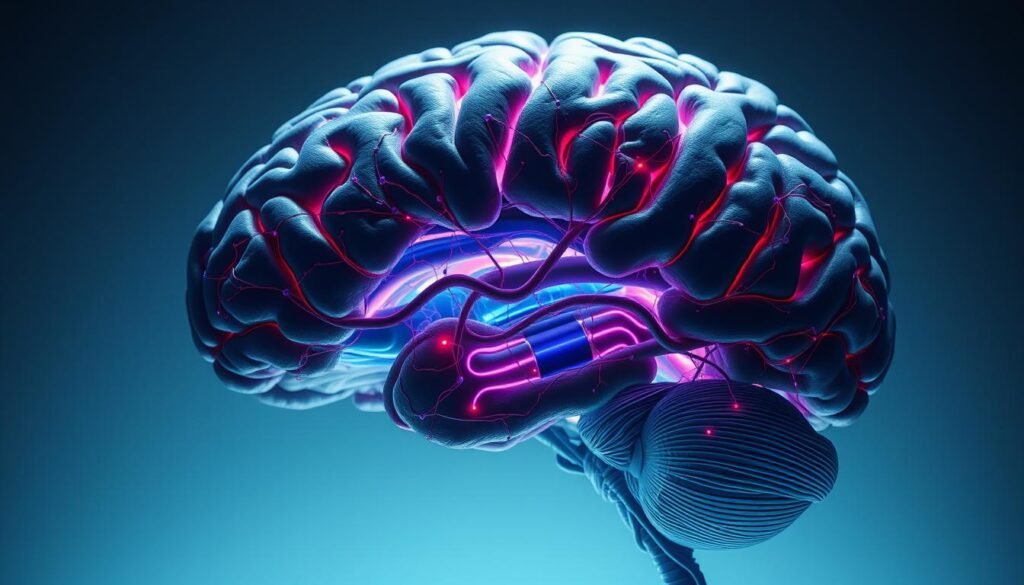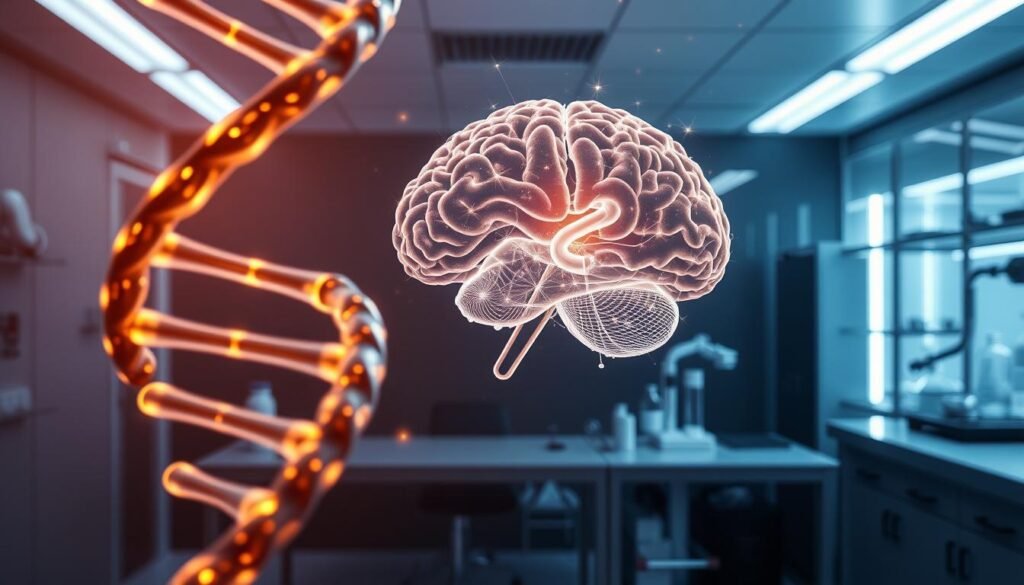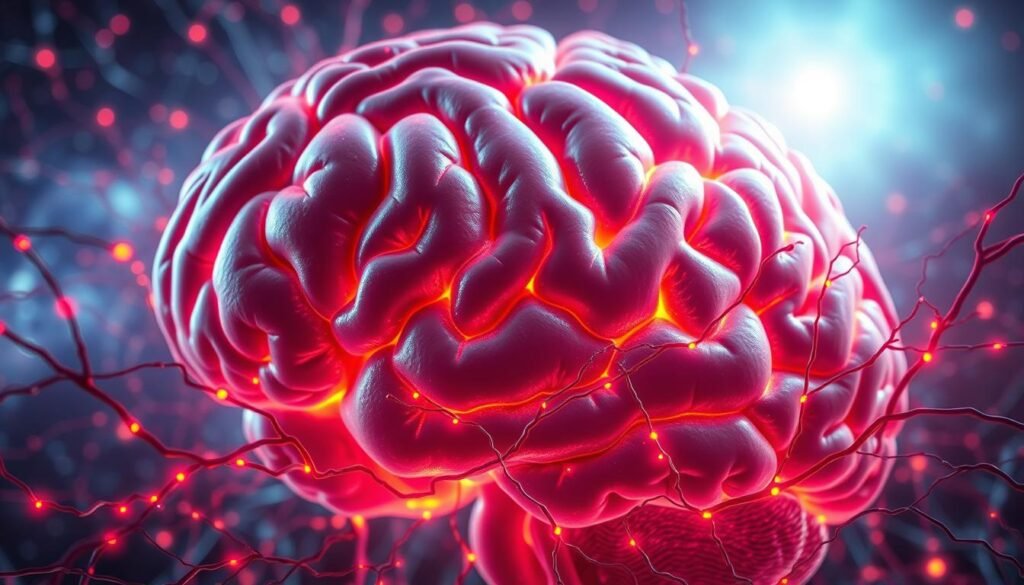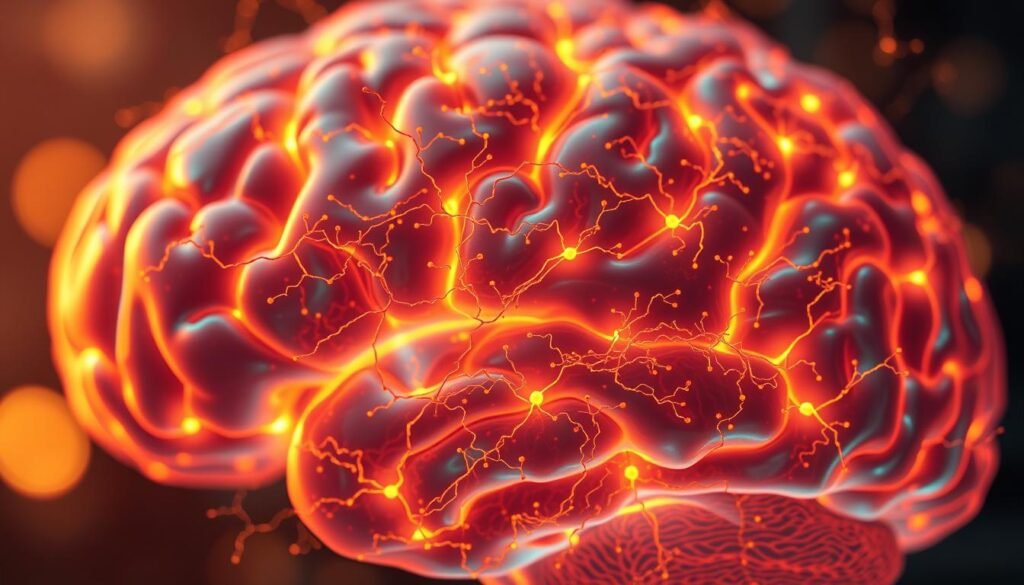Have you ever wondered how some people seem to effortlessly solve complex problems or maintain sharp mental clarity? The answer might lie in the power of targeted reading. Cognitive function plays a vital role in our daily lives, influencing decision-making, memory, and overall brain health.
Reading materials that focus on neuroscience, psychology, and practical strategies can significantly enhance mental clarity. This curated selection includes Nobel Prize-winning research and New York Times bestsellers, all with Goodreads ratings averaging 4+ stars. These resources are designed to help you unlock your mind’s full potential.
Whether you’re looking to improve problem-solving skills or boost brain health, these titles offer actionable insights. Dive into this list to discover how the right reading can transform your mental agility.
Key Takeaways
- Targeted reading can improve mental clarity and problem-solving skills.
- This selection combines neuroscience, psychology, and practical strategies.
- Includes Nobel Prize-winning research and NYT bestsellers.
- All titles have Goodreads ratings of 4+ stars.
- Designed to enhance brain health and cognitive function.
Introduction to Cognitive Function and the Power of Reading
Understanding how the brain works can unlock new ways to improve daily life. Cognitive abilities, such as memory, problem-solving, and decision-making, play a crucial role in how people navigate challenges and achieve success. These skills are not static; they can be developed and enhanced over time.
Globally, cognitive decline costs an estimated $2.8 trillion annually, according to the WHO. This highlights the importance of maintaining and improving mental sharpness. The prefrontal cortex, responsible for executive functions, develops significantly from adolescence through adulthood. Research by Steinberg shows how this part of the brain influences decision-making and self-control.
In real-world settings, cognitive abilities impact career performance and personal relationships. For example, better problem-solving skills can lead to professional growth, while improved emotional regulation strengthens connections with others. These abilities are not fixed; the concept of neuroplasticity, as explored by Doidge, shows that the brain can adapt and change throughout life.
By focusing on activities like reading, people can stimulate their minds and enhance cognitive function. This is a powerful way to maintain mental clarity and improve overall well-being.
1. Thinking, Fast and Slow by Daniel Kahneman
Daniel Kahneman’s work offers a deep dive into how our minds process information. This book explores the two systems that drive our thinking, providing insights into decision-making and mental clarity. With a Goodreads rating of 4.17/5 from over 554,000 reviews, it’s a must-read for anyone interested in understanding the brain.

Understanding the Two Systems of Thought
Kahneman introduces System 1 and System 2. System 1 is fast, intuitive, and automatic, while System 2 is slow, analytical, and deliberate. These systems shape the way we think and make decisions. For example, System 1 helps us react quickly to danger, while System 2 allows us to solve complex problems.
Understanding these systems can help us recognize when we’re relying on intuition versus careful analysis. This awareness is key to improving decision-making and avoiding common cognitive biases.
Key Takeaways for Cognitive Enhancement
Kahneman’s research highlights cognitive biases like the anchoring effect and loss aversion. These biases often lead to irrational decisions. By recognizing them, we can make better choices in both personal and professional settings.
The book also introduces Kahneman’s Nobel-winning prospect theory. This theory explains how people evaluate potential gains and losses. Practical exercises for meta-cognition development are included, helping readers become more aware of their thought processes.
For example, the working memory “shelf” analogy helps visualize how we store and process information. This concept can be applied to improve focus and mental clarity. By understanding these principles, readers can enhance their cognitive abilities and make smarter decisions.
2. The Man Who Mistook His Wife for a Hat by Oliver Sacks
The human brain is a complex organ, capable of both incredible feats and puzzling quirks. Oliver Sacks’ The Man Who Mistook His Wife for a Hat delves into these fascinating aspects, offering a collection of clinical stories that reveal the brain’s unique functions and dysfunctions. With a Goodreads rating of 4.05/5 from over 236,000 reviews, this book is a cornerstone in understanding the mysteries of the mind.
Exploring the Brain’s Quirks and Functions
Sacks examines unusual neurological conditions, such as visual agnosia and Capgras syndrome. These cases highlight how the brain processes information in unexpected ways. For instance, a patient with visual agnosia might mistake their spouse for a hat, showcasing the brain’s struggle to interpret visual cues.
Another intriguing example is the use of music therapy to aid patients with neurological disorders. Sacks demonstrates how neural plasticity allows the brain to adapt and rewire itself, even in the face of severe challenges. These stories not only captivate but also provide valuable insights into the brain’s resilience.
Lessons on Memory and Perception
Memory and perception are central themes in Sacks’ work. He explores how neurological conditions can alter these functions, offering lessons for understanding conditions like Alzheimer’s and dementia. For example, his observations on periodicity in neurological symptoms reveal patterns that can inform treatment approaches.
This book also underscores the importance of empathy in caregiving. By understanding the way the brain shapes perception, people can better support those with cognitive impairments. Sacks’ work reminds us that the world of the mind is as diverse as it is complex.
3. How the Mind Works by Steven Pinker
Ever thought about how the mind processes information and shapes our daily experiences? Steven Pinker’s How the Mind Works dives into this question, offering a blend of neuroscience, psychology, and evolutionary biology. With a Goodreads rating of 3.99/5 from over 20,000 reviews, this book is a valuable resource for understanding the brain’s inner workings.
Insights into Cognitive Processes
Pinker breaks down the computational theory of the mind, explaining how the brain processes information like a computer. He explores evolutionary psychology, particularly how humans assess risk and make decisions. For example, our ancestors’ survival instincts still influence modern behavior.
Case studies on visual perception, including optical illusions, reveal how the brain interprets sensory data. These examples highlight the gap between reality and perception, offering insights into how we see the world.
Practical Applications for Everyday Life
Pinker’s research on language acquisition at MIT shows how humans naturally learn and use language. This understanding can improve communication skills and foster better relationships.
The book also suggests conflict resolution strategies using theory of mind. By understanding others’ perspectives, we can navigate disagreements more effectively. These practical tools make Pinker’s work not just theoretical but actionable.
From understanding how the mind works to applying these insights in daily things, this book bridges the gap between science and real life. It’s a must-read for anyone curious about the human experience.
4. The Blank Slate: The Modern Denial of Human Nature by Steven Pinker
What if the way we think about human nature is fundamentally flawed? Steven Pinker’s *The Blank Slate* challenges the idea that the mind is a blank slate shaped solely by environment and experience. With a Goodreads rating of 4.09/5 from over 24,000 reviews, this book dives into the science of human nature and its impact on cognition.
Debunking Myths About the Mind
Pinker critiques the tabula rasa theory, which suggests that the mind is shaped entirely by external factors. He argues that biology plays a significant role in shaping our abilities and behaviors. For example, his analysis of gender differences in spatial reasoning highlights how innate traits influence performance in certain tasks.
This research also explores how modern education systems often overlook these biological factors. By understanding the mind’s natural tendencies, educators can create more effective teaching methods. This approach can help students thrive in school and beyond.
How Understanding Human Nature Can Improve Cognition
Pinker’s work offers practical insights into leveraging innate abilities. For instance, he discusses how recognizing our natural number sense can improve mathematical skills. This understanding can be applied to everyday things, from budgeting to problem-solving.
Additionally, the book examines how cognitive reframing can reduce violence and improve decision-making. By understanding the mind’s biases, people can make more rational choices. These strategies not only enhance cognition but also foster better relationships and societal harmony.
5. The Selfish Gene by Richard Dawkins
Have you considered how genetics shape the way we think and behave? Richard Dawkins’ The Selfish Gene explores this question, offering groundbreaking insights into the role of genes in shaping cognition. With a Goodreads rating of 4.16/5 from over 187,000 reviews, this book is a cornerstone in understanding the connection between genetics and the brain.
The Role of Genetics in Cognitive Function
Dawkins introduces the gene-centered view of evolution, explaining how genes drive behavior and decision-making. For example, kin selection theory shows how people prioritize family members in critical situations. This concept highlights the biological roots of altruism and cooperation.
Epigenetics also plays a role in cognitive development. Environmental factors can influence gene expression, shaping the brain over time. Dawkins’ research at Oxford provides valuable datasets that support these findings, offering a deeper understanding of how genetics impact mental processes.
Evolutionary Perspectives on the Mind
Dawkins’ meme theory explains how ideas spread in the digital age. Memes, like genes, evolve and influence the way people think. This concept provides a framework for understanding cultural and cognitive evolution.
By exploring these theories, readers gain insights into the biological and cultural forces that shape cognition. Dawkins’ work bridges the gap between science and everyday life, offering a fresh perspective on the human experience.
6. The Language Instinct: How the Mind Creates Language by Steven Pinker
How does language shape the way we think and process information? Steven Pinker’s The Language Instinct explores this question, offering insights into the relationship between language and cognition. With a Goodreads rating of 4.01/5 from over 22,000 reviews, this book is a must-read for understanding the brain’s role in communication.
The Connection Between Language and Cognition
Pinker’s work introduces the Universal Grammar theory, which suggests that the ability to learn language is hardwired into the brain. This theory explains why children can grasp complex grammar rules effortlessly. Case studies on aphasia, particularly those involving Broca’s area, reveal how damage to specific brain regions affects speech and comprehension.
Research on polyglots shows that learning multiple languages can enhance cognitive flexibility. Brain scans of polyglots demonstrate increased activity in areas responsible for problem-solving and memory. These findings highlight the mind’s adaptability and the benefits of multilingualism.
How Language Shapes Thought
Linguistic relativity, a key concept in Pinker’s book, explores how language influences perception. For example, studies on color perception show that different languages categorize colors in unique ways, affecting how people see the world. This idea challenges the notion that perception is universal.
Pinker also discusses the literacy network, a system in the brain that processes written and spoken language. Understanding this network can improve teaching methods and help people with reading difficulties. By exploring these concepts, Pinker bridges the gap between science and everyday things.
7. Consciousness Explained by Daniel C. Dennett
What drives our awareness and how does it shape our thoughts? Daniel C. Dennett’s *Consciousness Explained* dives into these questions, offering a groundbreaking perspective on the nature of consciousness. With a Goodreads rating of 3.90/5 from over 8,000 reviews, this book is a must-read for anyone curious about the workings of the brain.
Understanding Consciousness and Its Impact on Cognition
Dennett introduces the “multiple drafts” model, which suggests that consciousness is not a single narrative but a series of interpretations created by the brain. This model challenges traditional views and provides a fresh way to understand how we perceive the world.
He also discusses heterophenomenology, a research methodology that combines first-person experiences with scientific analysis. This approach helps bridge the gap between subjective experiences and objective things.
Case studies on blindsight reveal how the brain processes information subconsciously. These examples show that even without conscious awareness, the mind can still guide behavior and decision-making.
Practical Insights for Mental Clarity
Dennett’s self-model theory offers practical applications for improving mental clarity. For instance, meditation techniques based on this theory can help individuals become more aware of their thought processes.
By understanding how consciousness works, we can develop better strategies for managing stress and enhancing focus. These insights are not just theoretical but can be applied in everyday ways to improve overall well-being.
8. Incognito: The Secret Lives of the Brain by David Eagleman
What happens in your brain when you’re not actively thinking about it? David Eagleman’s *Incognito* takes readers on a journey into the hidden workings of the mind. With a Goodreads rating of 4.08/5 from over 33,000 reviews, this book reveals how much of our mental activity occurs behind the scenes.
Exploring the Unconscious Mind
Eagleman breaks down neural competition, showing how different parts of the brain vie for control during decision-making. This process explains why we sometimes struggle with choices, even when the answer seems obvious.
Split-brain research is another key focus. Eagleman discusses how the left and right hemispheres operate independently, yet work together to create a unified experience. This insight helps us understand how the brain handles complex tasks.
How the Brain Works Behind the Scenes
Subliminal marketing studies reveal how the brain processes information without conscious awareness. Eagleman’s analysis of these experiments highlights the power of hidden influences on behavior.
Time perception experiments are also explored. Eagleman shows how the brain can distort our sense of time, especially in high-stress situations. This understanding can help people manage their reactions in critical moments.
The “flashlight attention” analogy is another standout concept. It illustrates how the brain focuses on specific things while ignoring others, much like a flashlight illuminates only part of a room. This idea provides a clear way to understand attention and focus.
9. The Brain that Changes Itself by Norman Doidge
Can the brain truly rewire itself to overcome challenges? Norman Doidge’s *The Brain that Changes Itself* explores this fascinating concept, revealing how neuroplasticity allows the brain to adapt and heal. With a Goodreads rating of 4.20/5 from over 39,000 reviews, this book is a testament to the brain’s incredible ability to transform.
Neuroplasticity and Cognitive Improvement
Neuroplasticity is the brain’s ability to reorganize itself by forming new neural connections. Doidge’s research highlights how this process can improve cognitive function. For example, stroke recovery case studies show how patients regain lost abilities through targeted therapies.
Constraint-induced movement therapy is another key focus. This approach forces the brain to rewire itself by limiting the use of unaffected limbs. Studies on London taxi drivers also reveal how their hippocampi grow as they navigate the city’s complex streets.
Real-Life Stories of Brain Transformation
Doidge shares inspiring stories of people who have overcome significant challenges. One example is the adaptation timelines for cochlear implant users. These individuals learn to interpret new sounds, showcasing the brain’s adaptability.
Another story involves a woman who regained her ability to walk after a severe injury. Through persistent effort and neuroplasticity-based therapies, she rewired her brain to regain mobility. These examples demonstrate how the brain can change, even in adulthood.
Understanding neuroplasticity can transform how we approach learning and recovery. Whether in school or daily life, this knowledge empowers us to harness the brain’s potential for growth and healing.
10. Emotional Intelligence: Why It Can Matter More Than IQ by Daniel Goleman
Why do some individuals excel in managing emotions while others struggle? Daniel Goleman’s Emotional Intelligence explores this question, revealing how emotions shape our thoughts and actions. With a Goodreads rating of 4.05/5 from over 130,000 reviews, this book is a cornerstone in understanding the connection between emotions and the brain.
The Role of Emotions in Cognitive Function
Emotions play a critical role in how the brain processes information. Goleman introduces the concept of amygdala hijack, where intense emotions override rational thinking. Preventing this requires strategies like mindfulness and self-awareness. These techniques help people stay calm and focused, even in stressful situations.
The mirror neuron system is another key focus. This system allows us to empathize with others by mirroring their emotions. Studies show that empathy enhances teamwork and communication, making it essential in both personal and professional settings.
Emotional contagion, the phenomenon where emotions spread among groups, is also explored. Workplace studies reveal how positive emotions can boost productivity, while negative emotions can lead to conflict. Understanding this dynamic helps create healthier environments.
How to Develop Emotional Intelligence
Goleman’s 5-component model of emotional intelligence includes self-awareness, self-regulation, motivation, empathy, and social skills. Each component plays a vital role in personal growth. For example, self-regulation helps people manage impulses, while empathy strengthens relationships.
Emotional scaffolding, a concept from Source 2, emphasizes the importance of supportive environments in developing emotional intelligence. This approach encourages people to build skills gradually, fostering long-term growth.
By applying these strategies, individuals can enhance their emotional intelligence and improve their overall quality of life. Whether at work or in personal relationships, these skills are invaluable for navigating the complexities of modern life.
11. Predictably Irrational: The Hidden Forces That Shape Our Decisions by Dan Ariely
Why do we often make decisions that seem illogical or irrational? Dan Ariely’s *Predictably Irrational* explores the hidden forces behind our choices, revealing how cognitive biases influence our behavior. With a Goodreads rating of 4.12/5 from over 128,000 reviews, this book is a must-read for understanding the quirks of the human brain.
Understanding Cognitive Biases
Ariely’s research at MIT highlights how biases like the decoy effect shape our decisions. For example, in pricing strategies, adding a less attractive option can make another seem more appealing. This tactic is often used in marketing to influence consumer behavior.
The endowment effect is another key concept. It explains why people value items they own more than identical ones they don’t. This bias can impact personal finance decisions, leading to irrational choices about spending and saving.
Placebo effect studies also show how expectations influence outcomes. In pain management, believing a treatment works can reduce discomfort, even if the treatment is inactive. These findings reveal the power of the brain in shaping our experiences.
How to Make Better Decisions
Debiasing techniques can help people make more rational choices. For instance, in medical diagnoses, structured decision-making processes reduce errors caused by cognitive biases. These strategies ensure that critical decisions are based on evidence rather than intuition.
Ariely’s experiments also suggest that understanding our biases is the first step toward better decision-making. By recognizing the way our minds work, we can avoid common pitfalls and make smarter choices in everyday things.
From pricing strategies to personal finance, *Predictably Irrational* offers practical insights into the forces that shape our decisions. By applying these lessons, readers can navigate the complexities of the modern world with greater clarity and confidence.
12. Descartes’ Error: Emotion, Reason and the Human Brain by António Damásio
What if emotions are not just feelings but critical drivers of our decisions? António Damásio’s *Descartes’ Error* challenges the traditional separation of emotion and reason, revealing how deeply intertwined they are in the brain. With a Goodreads rating of 3.96/5 from over 9,000 reviews, this book is a must-read for understanding the role of emotions in shaping our thoughts and actions.
The Interplay Between Emotion and Reason
Damásio introduces the somatic marker hypothesis, a framework that explains how emotions guide decision-making. This theory suggests that emotional signals, or somatic markers, help people evaluate options quickly and efficiently. For example, when faced with a risky choice, these markers can trigger a gut feeling that steers us toward a safer option.
Case studies on the ventromedial prefrontal cortex highlight its role in this process. Damage to this area can impair decision-making, as seen in patients who struggle to weigh the consequences of their actions. These findings underscore the importance of emotions in rational thinking.
How Emotions Influence Cognitive Processes
The Iowa Gambling Task experiment is a key example of emotion-guided decision-making. Participants must choose between decks of cards with varying risks and rewards. Those with intact emotional processing tend to perform better, demonstrating how emotions can enhance cognitive function.
Damásio’s research at USC neurology further explores this connection. His work shows that emotions are not just byproducts of thought but essential components of the decision-making process. This understanding can help people improve their mental clarity and make more informed choices.
By recognizing the role of emotions in the mind and body, we can better understand how to harness them for cognitive improvement. Damásio’s insights bridge the gap between science and everyday life, offering practical tools for enhancing mental agility.
13. Self Comes to Mind: Constructing the Conscious Brain by António Damásio
How does the sense of self emerge from the complex workings of the brain? António Damásio’s *Self Comes to Mind* delves into this question, exploring the development of self and consciousness. With a Goodreads rating of 3.97/5 from over 3,000 reviews, this book offers a deep understanding of how the mind constructs awareness.
The Development of Self and Consciousness
Damásio introduces the proto-self to core consciousness continuum. This model explains how the brain transitions from basic awareness to a more complex sense of self. For example, the proto-self is responsible for maintaining bodily functions, while core consciousness allows us to experience the present moment.
Body mapping in the insular cortex is another key focus. This process helps the brain create a sense of physical presence. Case studies on anosognosia, where patients are unaware of their own conditions, reveal how disruptions in this mapping can affect self-awareness.
Implications for Cognitive Function
Meditation’s impact on self-processes is also explored. Practices like mindfulness can enhance self-awareness by strengthening neural connections in the brain. This leads to improved focus and emotional regulation, which are essential for cognitive function.
Damásio’s consciousness hierarchy model provides a framework for understanding these processes. This model shows how different levels of consciousness interact to create a unified sense of self. By studying these interactions, people can gain insights into their own mental processes.
Understanding the development of self and consciousness can transform how we approach mental clarity. Whether through meditation or research, these insights offer practical tools for enhancing cognitive abilities over time.
14. Mind Maps: Quicker Notes, Better Memory, and Improved Learning 2.0 by Michael Taylor
What if there was a tool that could transform how you process and retain information? Michael Taylor’s Mind Maps: Quicker Notes, Better Memory, and Improved Learning 2.0 introduces a powerful method for enhancing memory and learning. With a Goodreads rating of 3.63/5 from 529 reviews, this book is a practical guide to mastering mind maps.
Techniques for Enhancing Memory and Learning
Mind maps leverage dual coding theory, combining visuals and words to improve retention. This approach helps the brain process information more effectively. For example, medical student retention studies show that those using mind maps perform better in exams.
Chunking strategies are another key technique. Breaking complex information into smaller, manageable parts makes it easier to remember. This method is especially useful for subjects like anatomy or chemistry, where details can overwhelm the brain.
Color psychology also plays a role in information encoding. Using specific colors to highlight key points can enhance memory recall. This strategy taps into the brain’s natural ability to associate colors with concepts.
How to Use Mind Maps Effectively
Retrieval practice, emphasized in Source 2, is crucial for long-term learning. Regularly revisiting mind maps strengthens neural connections, making information easier to recall. This technique is particularly effective for people preparing for exams or presentations.
Creating mind maps is a simple yet impactful way to organize thoughts. Start with a central idea and branch out with related concepts. This visual structure mirrors how the brain naturally processes information, making it a powerful tool for learning.
By incorporating these strategies, individuals can enhance their memory and learning abilities. Whether for academic success or personal growth, mind maps offer a practical solution for improving cognitive performance.
15. Brain Rules: 12 Principles for Surviving and Thriving at Work, Home, and School by John Medina
What if simple daily habits could significantly boost your brain’s performance? John Medina’s *Brain Rules* explores 12 principles that can help you thrive in various aspects of life. With a Goodreads rating of 4.01/5 from 34,000 reviews, this book is a practical guide to understanding and optimizing your brain’s potential.
Practical Rules for Brain Health
One key principle is the 10-minute attention rule. Studies show that people’s focus wanes after 10 minutes, making shorter, more frequent breaks essential for productivity. This rule is especially useful in meetings or classroom settings.
Exercise is another critical factor. Physical activity increases BDNF production, a protein that supports brain health and cognitive function. Regular exercise can improve memory, focus, and overall mental clarity.
Sleep plays a vital role in memory consolidation. Research indicates that quality sleep helps the brain process and store information effectively. Prioritizing rest can lead to better learning outcomes and decision-making.
How to Apply These Principles in Daily Life
Creating a multisensory learning environment can enhance retention. Combining visual, auditory, and tactile elements helps the brain process information more efficiently. This approach is particularly effective in schools and workplaces.
Medina’s molecular biology research underscores the importance of these principles. By understanding how the brain works, people can make informed choices to improve their mental performance over time.
From exercise to sleep, these practical strategies can transform how you approach daily tasks. By applying these rules, you can unlock your brain’s full potential and thrive in every aspect of life.
Conclusion: Enhance Your Cognitive Function with These Best Books
Exploring the science behind mental clarity can transform how we approach daily challenges. The brain’s ability to adapt and grow, as highlighted in these resources, offers a roadmap for lifelong learning. By incorporating deliberate practice, you can create a personalized training regimen that fits your needs.
Interleaving different categories of reading material keeps the mind engaged and fosters deeper understanding. Start by setting small, achievable goals and gradually build on them. This way, you can make steady progress without feeling overwhelmed.
Neuroscience research shows that consistent effort leads to lasting cognitive benefits. Whether you’re improving memory or enhancing problem-solving skills, the key is to stay curious and committed. Begin today and unlock your full potential.
FAQ
Why is cognitive function important?
Cognitive function is crucial because it affects how we think, learn, remember, and make decisions. Improving it can enhance mental clarity, focus, and overall quality of life.
How does reading improve cognitive function?
Reading stimulates the brain, enhances vocabulary, and improves memory and concentration. It also encourages critical thinking and problem-solving skills.
What are the key takeaways from "Thinking, Fast and Slow"?
Daniel Kahneman’s book explains how the brain operates through two systems: fast, intuitive thinking and slow, logical reasoning. Understanding these systems can help improve decision-making and mental clarity.
What can I learn from "The Man Who Mistook His Wife for a Hat"?
Oliver Sacks explores fascinating cases of brain disorders, offering insights into memory, perception, and the brain’s adaptability. It highlights the complexity of the human mind.
How does "How the Mind Works" explain cognitive processes?
Steven Pinker delves into how the brain processes information, solves problems, and creates thoughts. The book provides practical ways to apply these insights in daily life.
What does "The Blank Slate" reveal about human nature?
Pinker challenges the idea that the mind is a blank slate, showing how genetics and evolution shape cognition. Understanding this can lead to better self-awareness and mental growth.
How does "The Selfish Gene" relate to cognitive function?
Richard Dawkins explains how genetics influence behavior and thought processes. This evolutionary perspective helps us understand the roots of cognition.
What is the connection between language and cognition in "The Language Instinct"?
Pinker argues that language is an innate ability that shapes how we think. Understanding this link can improve communication and cognitive skills.
What does "Consciousness Explained" teach us about the mind?
Daniel Dennett explores the nature of consciousness and its role in cognition. The book offers practical insights for achieving mental clarity.
How does "Incognito" explore the unconscious mind?
David Eagleman reveals how much of the brain’s activity happens unconsciously. Understanding this can help us make better decisions and improve mental function.
What is neuroplasticity, and how does "The Brain That Changes Itself" explain it?
Neuroplasticity is the brain’s ability to reorganize itself. Norman Doidge shares real-life stories of brain transformation, showing how we can improve cognition through effort and practice.
Why is emotional intelligence important for cognitive function?
Daniel Goleman explains how emotions influence thinking and decision-making. Developing emotional intelligence can enhance mental clarity and interpersonal skills.
How does "Predictably Irrational" help us understand cognitive biases?
Dan Ariely explores the hidden forces behind decision-making. Recognizing these biases can lead to better choices and improved cognitive function.
What is the relationship between emotion and reason in "Descartes’ Error"?
António Damásio shows how emotions and reason are intertwined. Understanding this connection can improve decision-making and mental clarity.
How does "Self Comes to Mind" explain the development of consciousness?
Damásio explores how the brain constructs the self and consciousness. This understanding has significant implications for cognitive function and self-awareness.
How can mind maps improve memory and learning?
Michael Taylor’s book teaches techniques for organizing information visually. Using mind maps can enhance memory, creativity, and learning efficiency.
What are the key principles in "Brain Rules" for brain health?
John Medina outlines 12 principles for optimizing brain function, including exercise, sleep, and stress management. Applying these can improve mental performance in daily life.










